Enterprise Environmental Factors Analysis: Ford Motors Case Study
VerifiedAdded on 2023/01/24
|12
|2807
|35
AI Summary
This report discusses the impact of enterprise environmental factors on project management processes using the case study of Ford Motors. It evaluates internal and external factors, develops strategies for implementation, and drafts a communication plan for diverse stakeholders.
Contribute Materials
Your contribution can guide someone’s learning journey. Share your
documents today.
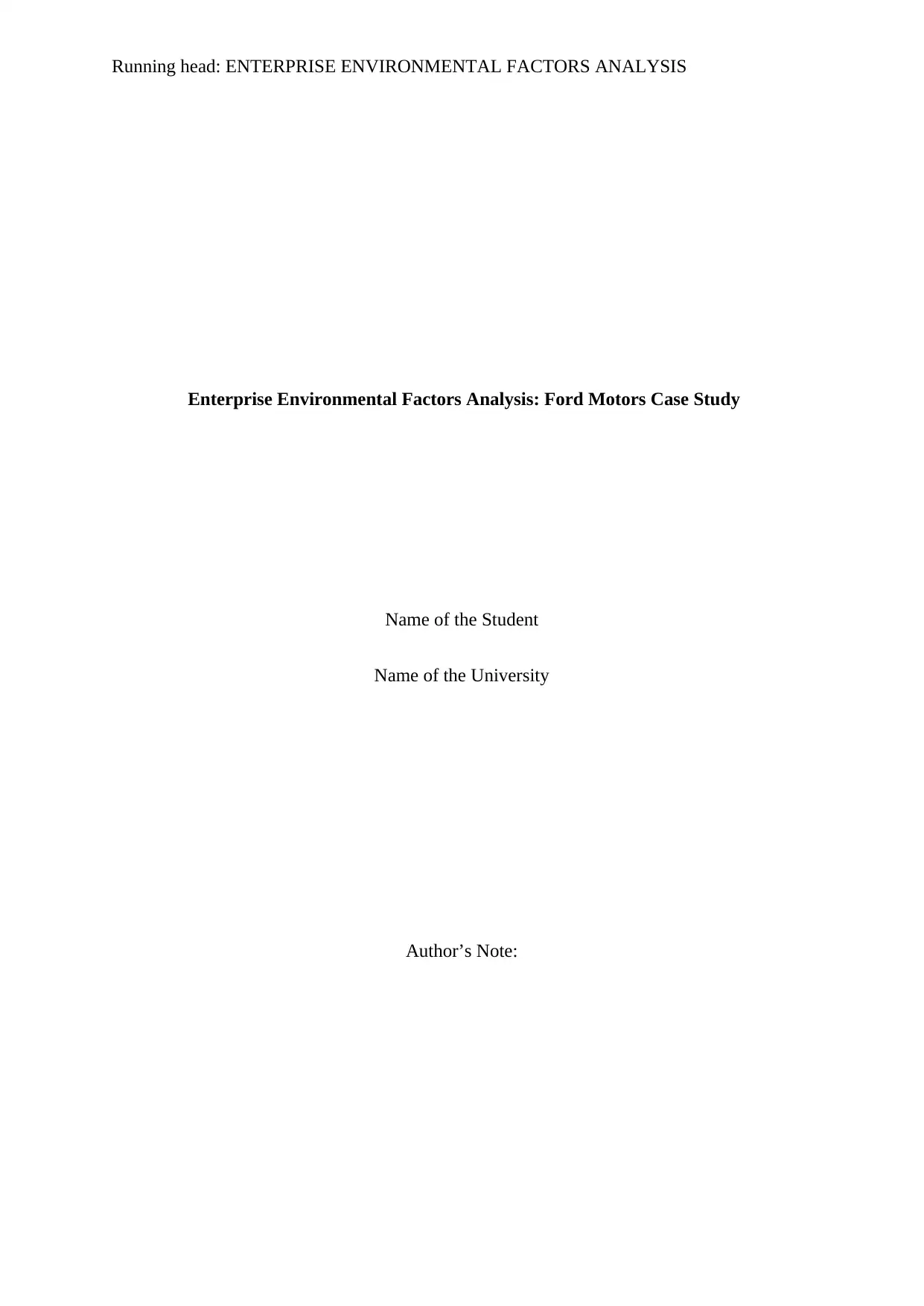
Running head: ENTERPRISE ENVIRONMENTAL FACTORS ANALYSIS
Enterprise Environmental Factors Analysis: Ford Motors Case Study
Name of the Student
Name of the University
Author’s Note:
Enterprise Environmental Factors Analysis: Ford Motors Case Study
Name of the Student
Name of the University
Author’s Note:
Secure Best Marks with AI Grader
Need help grading? Try our AI Grader for instant feedback on your assignments.
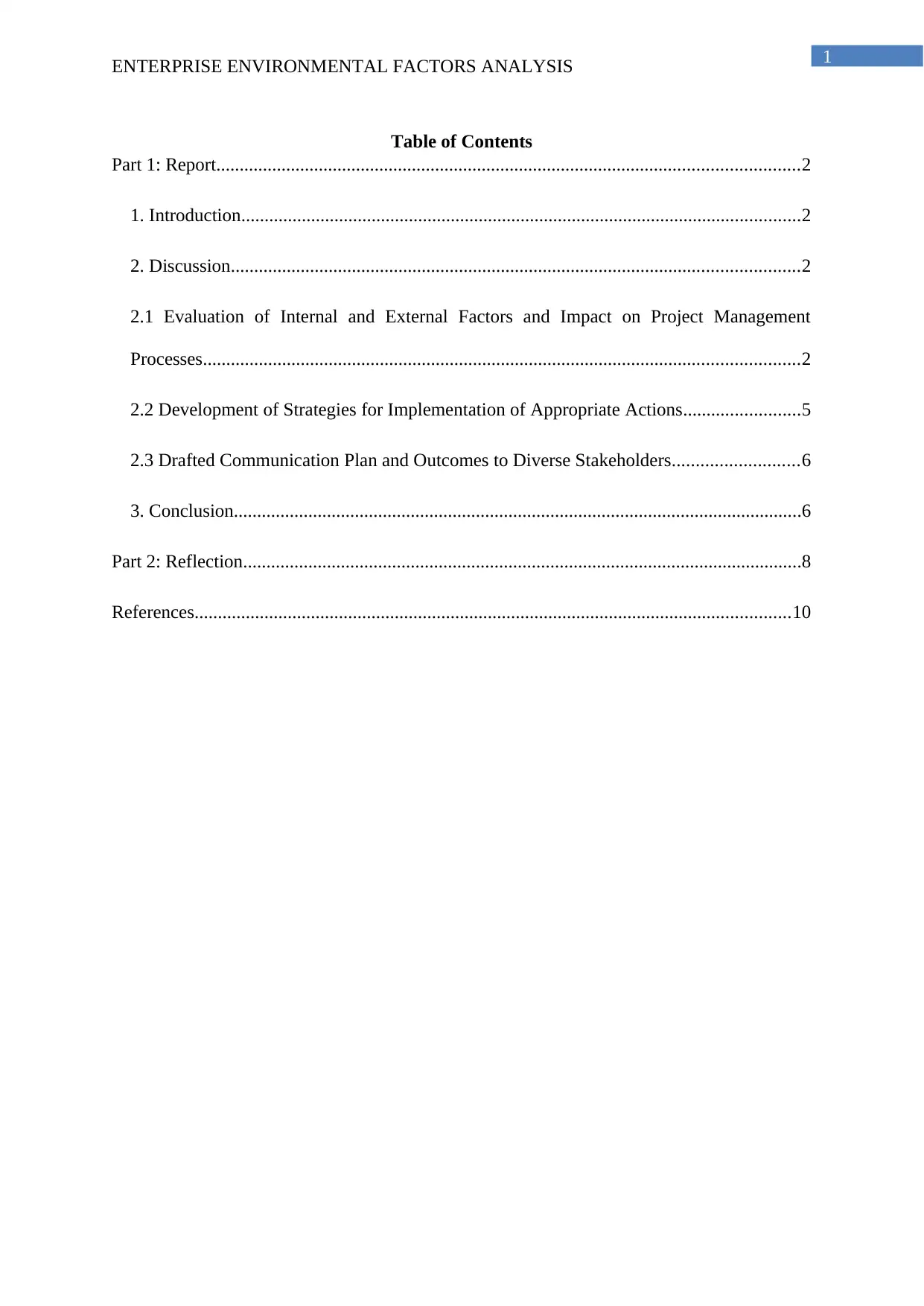
1
ENTERPRISE ENVIRONMENTAL FACTORS ANALYSIS
Table of Contents
Part 1: Report.............................................................................................................................2
1. Introduction........................................................................................................................2
2. Discussion..........................................................................................................................2
2.1 Evaluation of Internal and External Factors and Impact on Project Management
Processes................................................................................................................................2
2.2 Development of Strategies for Implementation of Appropriate Actions.........................5
2.3 Drafted Communication Plan and Outcomes to Diverse Stakeholders...........................6
3. Conclusion..........................................................................................................................6
Part 2: Reflection........................................................................................................................8
References................................................................................................................................10
ENTERPRISE ENVIRONMENTAL FACTORS ANALYSIS
Table of Contents
Part 1: Report.............................................................................................................................2
1. Introduction........................................................................................................................2
2. Discussion..........................................................................................................................2
2.1 Evaluation of Internal and External Factors and Impact on Project Management
Processes................................................................................................................................2
2.2 Development of Strategies for Implementation of Appropriate Actions.........................5
2.3 Drafted Communication Plan and Outcomes to Diverse Stakeholders...........................6
3. Conclusion..........................................................................................................................6
Part 2: Reflection........................................................................................................................8
References................................................................................................................................10
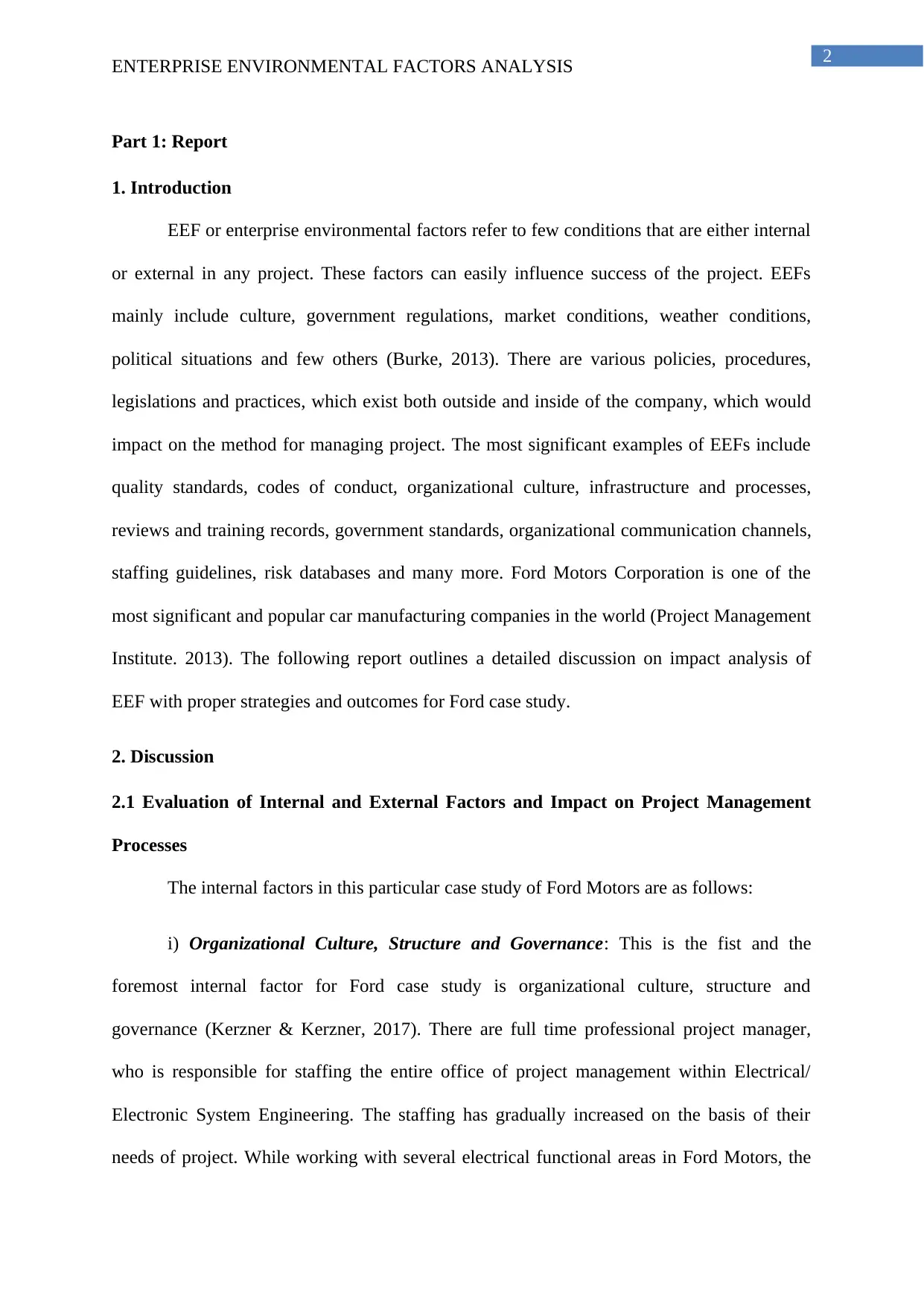
2
ENTERPRISE ENVIRONMENTAL FACTORS ANALYSIS
Part 1: Report
1. Introduction
EEF or enterprise environmental factors refer to few conditions that are either internal
or external in any project. These factors can easily influence success of the project. EEFs
mainly include culture, government regulations, market conditions, weather conditions,
political situations and few others (Burke, 2013). There are various policies, procedures,
legislations and practices, which exist both outside and inside of the company, which would
impact on the method for managing project. The most significant examples of EEFs include
quality standards, codes of conduct, organizational culture, infrastructure and processes,
reviews and training records, government standards, organizational communication channels,
staffing guidelines, risk databases and many more. Ford Motors Corporation is one of the
most significant and popular car manufacturing companies in the world (Project Management
Institute. 2013). The following report outlines a detailed discussion on impact analysis of
EEF with proper strategies and outcomes for Ford case study.
2. Discussion
2.1 Evaluation of Internal and External Factors and Impact on Project Management
Processes
The internal factors in this particular case study of Ford Motors are as follows:
i) Organizational Culture, Structure and Governance: This is the fist and the
foremost internal factor for Ford case study is organizational culture, structure and
governance (Kerzner & Kerzner, 2017). There are full time professional project manager,
who is responsible for staffing the entire office of project management within Electrical/
Electronic System Engineering. The staffing has gradually increased on the basis of their
needs of project. While working with several electrical functional areas in Ford Motors, the
ENTERPRISE ENVIRONMENTAL FACTORS ANALYSIS
Part 1: Report
1. Introduction
EEF or enterprise environmental factors refer to few conditions that are either internal
or external in any project. These factors can easily influence success of the project. EEFs
mainly include culture, government regulations, market conditions, weather conditions,
political situations and few others (Burke, 2013). There are various policies, procedures,
legislations and practices, which exist both outside and inside of the company, which would
impact on the method for managing project. The most significant examples of EEFs include
quality standards, codes of conduct, organizational culture, infrastructure and processes,
reviews and training records, government standards, organizational communication channels,
staffing guidelines, risk databases and many more. Ford Motors Corporation is one of the
most significant and popular car manufacturing companies in the world (Project Management
Institute. 2013). The following report outlines a detailed discussion on impact analysis of
EEF with proper strategies and outcomes for Ford case study.
2. Discussion
2.1 Evaluation of Internal and External Factors and Impact on Project Management
Processes
The internal factors in this particular case study of Ford Motors are as follows:
i) Organizational Culture, Structure and Governance: This is the fist and the
foremost internal factor for Ford case study is organizational culture, structure and
governance (Kerzner & Kerzner, 2017). There are full time professional project manager,
who is responsible for staffing the entire office of project management within Electrical/
Electronic System Engineering. The staffing has gradually increased on the basis of their
needs of project. While working with several electrical functional areas in Ford Motors, the

3
ENTERPRISE ENVIRONMENTAL FACTORS ANALYSIS
respective project managers are assigned to corporate and departmental strategic products for
working on the tools, methodologies and processes of project management. The governance
board in Ford Motors is responsible for reviewing the subsequent progress of project for
giving necessary approval and rejection for recommendations.
ii) Infrastructure: The organizational infrastructure refers to existing facilities,
capacity, availability, information technology hardware and organizational
telecommunication channels (Larson & Gray, 2017). The major growth and customer
requirements are easily and promptly met by having an error free infrastructure. Ford Motors
even has upgraded technology and it is responsible for making their business structured and
effective.
iii) Information Technology Software: The next internal factor is IT software. The
major examples of this type of software include web interface to another online automated
system, configuration management system, and scheduling software tool as well as work
authorization system (Walker, 2015). The project scope is being structured and negotiated in
an efficient manner for maintaining consistency in the project management delivery.
iv) Employee Capability: Ford pays extra attention to the employee capability
evaluation (Heagney, 2016). They ensure that only skilled and specialized employees are
being selected in the organization and human resource expertise is kept on top priority.
Although, they have 327,531 employees worldwide, major emphasis is provided to the
capabilities of employees. The aptitude of employees is accessed so that it becomes easy for
them to analyse which employees would be better for the organization.
v) Resource Availability: The availability of resources is yet another important
internal factor that has a major impact on Ford Motors (Mir & Pinnington, 2014). The
contracting and purchasing of constraints, collaboration agreements and approved providers
ENTERPRISE ENVIRONMENTAL FACTORS ANALYSIS
respective project managers are assigned to corporate and departmental strategic products for
working on the tools, methodologies and processes of project management. The governance
board in Ford Motors is responsible for reviewing the subsequent progress of project for
giving necessary approval and rejection for recommendations.
ii) Infrastructure: The organizational infrastructure refers to existing facilities,
capacity, availability, information technology hardware and organizational
telecommunication channels (Larson & Gray, 2017). The major growth and customer
requirements are easily and promptly met by having an error free infrastructure. Ford Motors
even has upgraded technology and it is responsible for making their business structured and
effective.
iii) Information Technology Software: The next internal factor is IT software. The
major examples of this type of software include web interface to another online automated
system, configuration management system, and scheduling software tool as well as work
authorization system (Walker, 2015). The project scope is being structured and negotiated in
an efficient manner for maintaining consistency in the project management delivery.
iv) Employee Capability: Ford pays extra attention to the employee capability
evaluation (Heagney, 2016). They ensure that only skilled and specialized employees are
being selected in the organization and human resource expertise is kept on top priority.
Although, they have 327,531 employees worldwide, major emphasis is provided to the
capabilities of employees. The aptitude of employees is accessed so that it becomes easy for
them to analyse which employees would be better for the organization.
v) Resource Availability: The availability of resources is yet another important
internal factor that has a major impact on Ford Motors (Mir & Pinnington, 2014). The
contracting and purchasing of constraints, collaboration agreements and approved providers
Secure Best Marks with AI Grader
Need help grading? Try our AI Grader for instant feedback on your assignments.
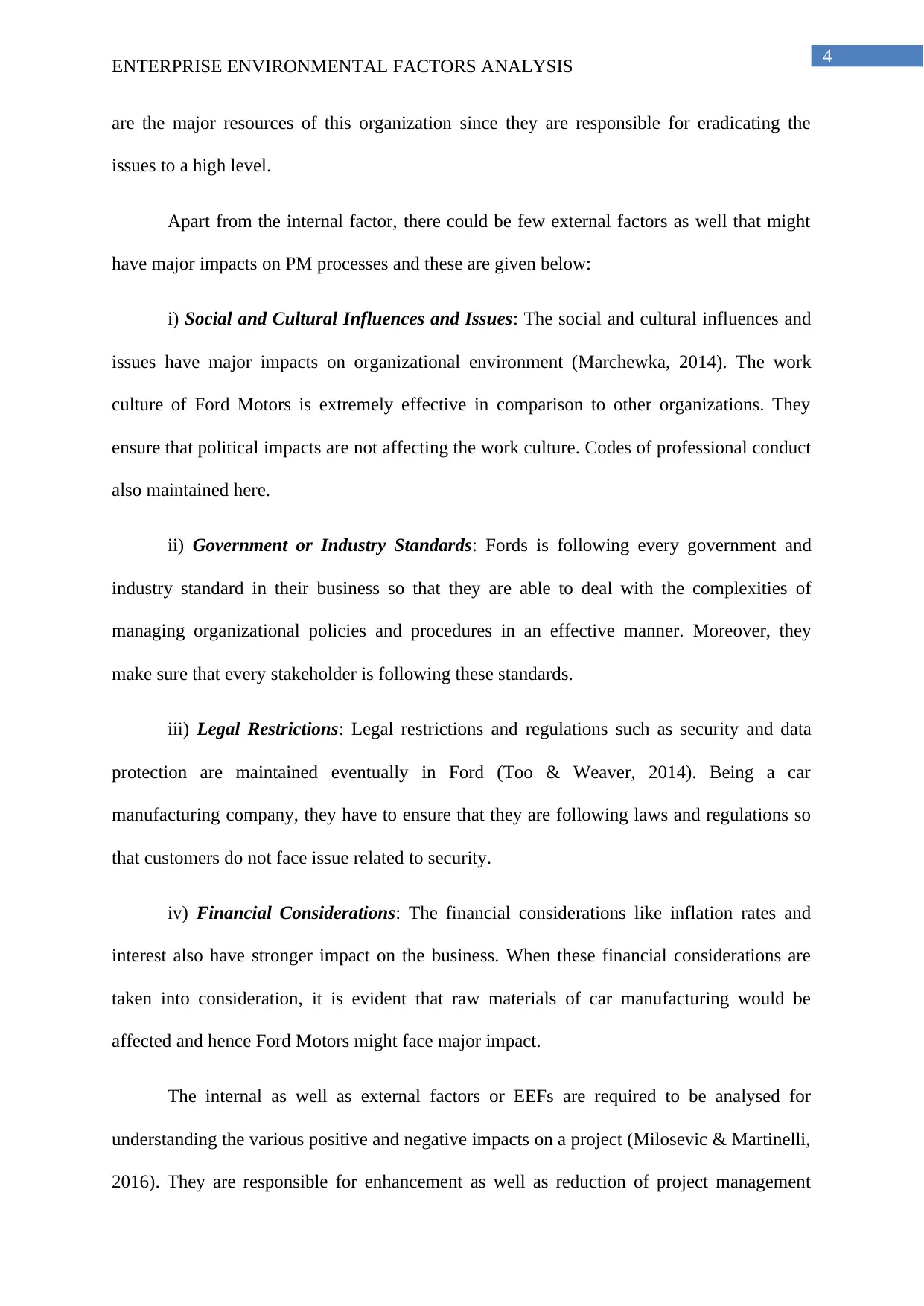
4
ENTERPRISE ENVIRONMENTAL FACTORS ANALYSIS
are the major resources of this organization since they are responsible for eradicating the
issues to a high level.
Apart from the internal factor, there could be few external factors as well that might
have major impacts on PM processes and these are given below:
i) Social and Cultural Influences and Issues: The social and cultural influences and
issues have major impacts on organizational environment (Marchewka, 2014). The work
culture of Ford Motors is extremely effective in comparison to other organizations. They
ensure that political impacts are not affecting the work culture. Codes of professional conduct
also maintained here.
ii) Government or Industry Standards: Fords is following every government and
industry standard in their business so that they are able to deal with the complexities of
managing organizational policies and procedures in an effective manner. Moreover, they
make sure that every stakeholder is following these standards.
iii) Legal Restrictions: Legal restrictions and regulations such as security and data
protection are maintained eventually in Ford (Too & Weaver, 2014). Being a car
manufacturing company, they have to ensure that they are following laws and regulations so
that customers do not face issue related to security.
iv) Financial Considerations: The financial considerations like inflation rates and
interest also have stronger impact on the business. When these financial considerations are
taken into consideration, it is evident that raw materials of car manufacturing would be
affected and hence Ford Motors might face major impact.
The internal as well as external factors or EEFs are required to be analysed for
understanding the various positive and negative impacts on a project (Milosevic & Martinelli,
2016). They are responsible for enhancement as well as reduction of project management
ENTERPRISE ENVIRONMENTAL FACTORS ANALYSIS
are the major resources of this organization since they are responsible for eradicating the
issues to a high level.
Apart from the internal factor, there could be few external factors as well that might
have major impacts on PM processes and these are given below:
i) Social and Cultural Influences and Issues: The social and cultural influences and
issues have major impacts on organizational environment (Marchewka, 2014). The work
culture of Ford Motors is extremely effective in comparison to other organizations. They
ensure that political impacts are not affecting the work culture. Codes of professional conduct
also maintained here.
ii) Government or Industry Standards: Fords is following every government and
industry standard in their business so that they are able to deal with the complexities of
managing organizational policies and procedures in an effective manner. Moreover, they
make sure that every stakeholder is following these standards.
iii) Legal Restrictions: Legal restrictions and regulations such as security and data
protection are maintained eventually in Ford (Too & Weaver, 2014). Being a car
manufacturing company, they have to ensure that they are following laws and regulations so
that customers do not face issue related to security.
iv) Financial Considerations: The financial considerations like inflation rates and
interest also have stronger impact on the business. When these financial considerations are
taken into consideration, it is evident that raw materials of car manufacturing would be
affected and hence Ford Motors might face major impact.
The internal as well as external factors or EEFs are required to be analysed for
understanding the various positive and negative impacts on a project (Milosevic & Martinelli,
2016). They are responsible for enhancement as well as reduction of project management
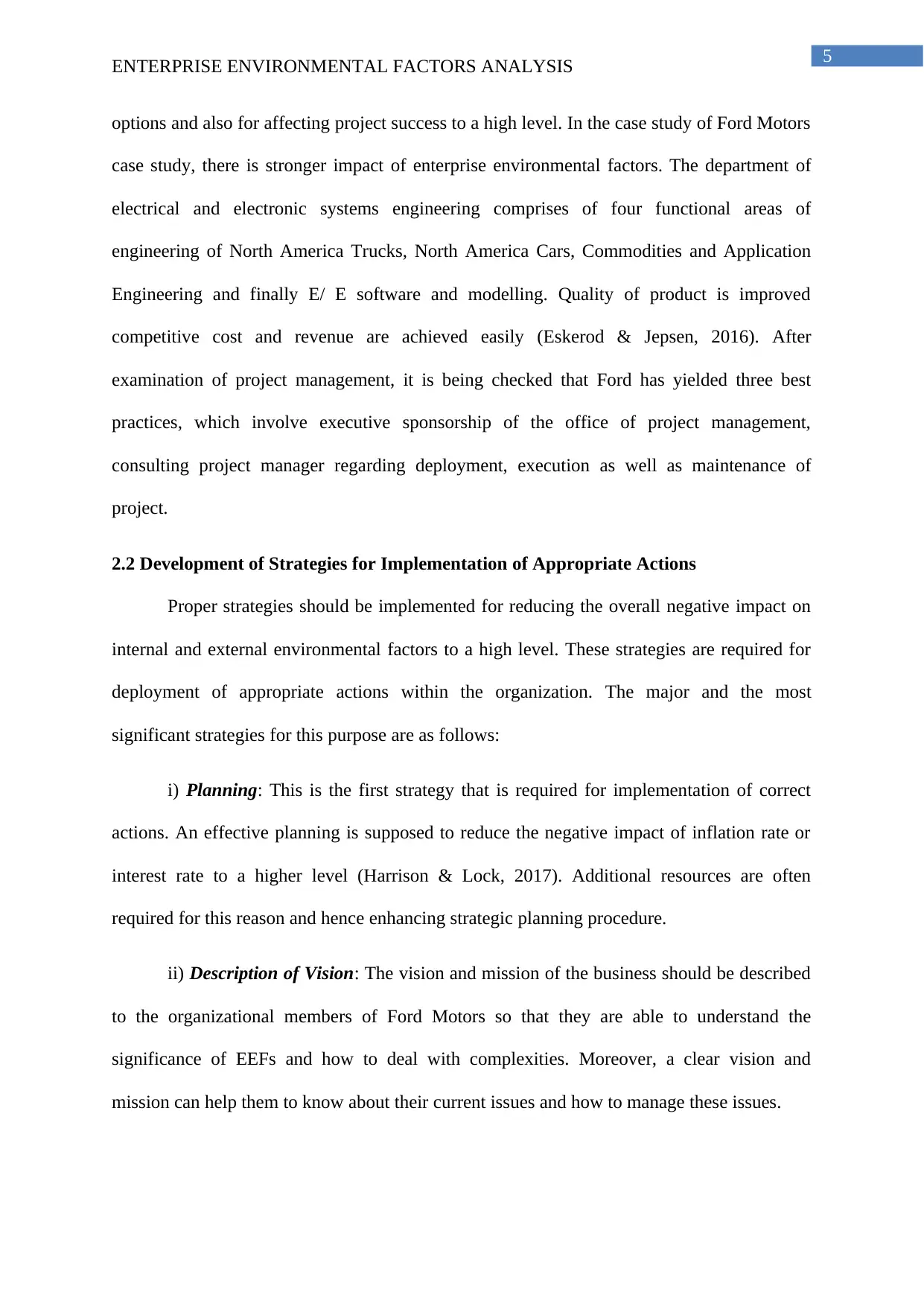
5
ENTERPRISE ENVIRONMENTAL FACTORS ANALYSIS
options and also for affecting project success to a high level. In the case study of Ford Motors
case study, there is stronger impact of enterprise environmental factors. The department of
electrical and electronic systems engineering comprises of four functional areas of
engineering of North America Trucks, North America Cars, Commodities and Application
Engineering and finally E/ E software and modelling. Quality of product is improved
competitive cost and revenue are achieved easily (Eskerod & Jepsen, 2016). After
examination of project management, it is being checked that Ford has yielded three best
practices, which involve executive sponsorship of the office of project management,
consulting project manager regarding deployment, execution as well as maintenance of
project.
2.2 Development of Strategies for Implementation of Appropriate Actions
Proper strategies should be implemented for reducing the overall negative impact on
internal and external environmental factors to a high level. These strategies are required for
deployment of appropriate actions within the organization. The major and the most
significant strategies for this purpose are as follows:
i) Planning: This is the first strategy that is required for implementation of correct
actions. An effective planning is supposed to reduce the negative impact of inflation rate or
interest rate to a higher level (Harrison & Lock, 2017). Additional resources are often
required for this reason and hence enhancing strategic planning procedure.
ii) Description of Vision: The vision and mission of the business should be described
to the organizational members of Ford Motors so that they are able to understand the
significance of EEFs and how to deal with complexities. Moreover, a clear vision and
mission can help them to know about their current issues and how to manage these issues.
ENTERPRISE ENVIRONMENTAL FACTORS ANALYSIS
options and also for affecting project success to a high level. In the case study of Ford Motors
case study, there is stronger impact of enterprise environmental factors. The department of
electrical and electronic systems engineering comprises of four functional areas of
engineering of North America Trucks, North America Cars, Commodities and Application
Engineering and finally E/ E software and modelling. Quality of product is improved
competitive cost and revenue are achieved easily (Eskerod & Jepsen, 2016). After
examination of project management, it is being checked that Ford has yielded three best
practices, which involve executive sponsorship of the office of project management,
consulting project manager regarding deployment, execution as well as maintenance of
project.
2.2 Development of Strategies for Implementation of Appropriate Actions
Proper strategies should be implemented for reducing the overall negative impact on
internal and external environmental factors to a high level. These strategies are required for
deployment of appropriate actions within the organization. The major and the most
significant strategies for this purpose are as follows:
i) Planning: This is the first strategy that is required for implementation of correct
actions. An effective planning is supposed to reduce the negative impact of inflation rate or
interest rate to a higher level (Harrison & Lock, 2017). Additional resources are often
required for this reason and hence enhancing strategic planning procedure.
ii) Description of Vision: The vision and mission of the business should be described
to the organizational members of Ford Motors so that they are able to understand the
significance of EEFs and how to deal with complexities. Moreover, a clear vision and
mission can help them to know about their current issues and how to manage these issues.

6
ENTERPRISE ENVIRONMENTAL FACTORS ANALYSIS
iii) Development of Action Plan for Achieving Goals: The next action in this case is
to develop an effective action plan for fulfilling goals as well as objectives (Project
Management Institute. 2017). System changes are required to be identified and hence for
each strategy, a formal decision is to be secured and priority is given to changes with higher
feasibility and importance.
2.3 Drafted Communication Plan and Outcomes to Diverse Stakeholders
A communication plan is needed to be drafted for maintaining major effectiveness
and efficiency within the business. It is a policy-driven approach for giving stakeholders with
significant information. The information that is required to be delivered should be effectively
enhanced and proper mode of communication is required to be analysed for delivering this
type of information (Morris, 2013). Sensitive information is anticipated by this type of
planning and specified audience segments are targeted in this factor. Information related to
manufacturing car parts in Ford Motors Corporation should be disseminated and the plan
should define which stakeholders of communication channels would utilize for soliciting
feedback and process of communication would be documented as well as archived.
In project management of Ford Motors Corporation, communication plan mainly
involves few terms and reports for communication of information. The diverse stakeholders
like managers and employees or workers are majorly affected if a proper communication plan
is being drafted in the business. Stakeholder management is possible for providing major
advantages and thus expectations of stakeholders are easily and promptly met without much
complexity (Schwalbe, 2015). The senior level managers within the organization have higher
expectations for 100% compliance with the major methodologies and tools of project
management that are being developed by project management office. Hence, project visibility
is obtained and a senior stakeholder is able to reduce the complexities.
ENTERPRISE ENVIRONMENTAL FACTORS ANALYSIS
iii) Development of Action Plan for Achieving Goals: The next action in this case is
to develop an effective action plan for fulfilling goals as well as objectives (Project
Management Institute. 2017). System changes are required to be identified and hence for
each strategy, a formal decision is to be secured and priority is given to changes with higher
feasibility and importance.
2.3 Drafted Communication Plan and Outcomes to Diverse Stakeholders
A communication plan is needed to be drafted for maintaining major effectiveness
and efficiency within the business. It is a policy-driven approach for giving stakeholders with
significant information. The information that is required to be delivered should be effectively
enhanced and proper mode of communication is required to be analysed for delivering this
type of information (Morris, 2013). Sensitive information is anticipated by this type of
planning and specified audience segments are targeted in this factor. Information related to
manufacturing car parts in Ford Motors Corporation should be disseminated and the plan
should define which stakeholders of communication channels would utilize for soliciting
feedback and process of communication would be documented as well as archived.
In project management of Ford Motors Corporation, communication plan mainly
involves few terms and reports for communication of information. The diverse stakeholders
like managers and employees or workers are majorly affected if a proper communication plan
is being drafted in the business. Stakeholder management is possible for providing major
advantages and thus expectations of stakeholders are easily and promptly met without much
complexity (Schwalbe, 2015). The senior level managers within the organization have higher
expectations for 100% compliance with the major methodologies and tools of project
management that are being developed by project management office. Hence, project visibility
is obtained and a senior stakeholder is able to reduce the complexities.
Paraphrase This Document
Need a fresh take? Get an instant paraphrase of this document with our AI Paraphraser
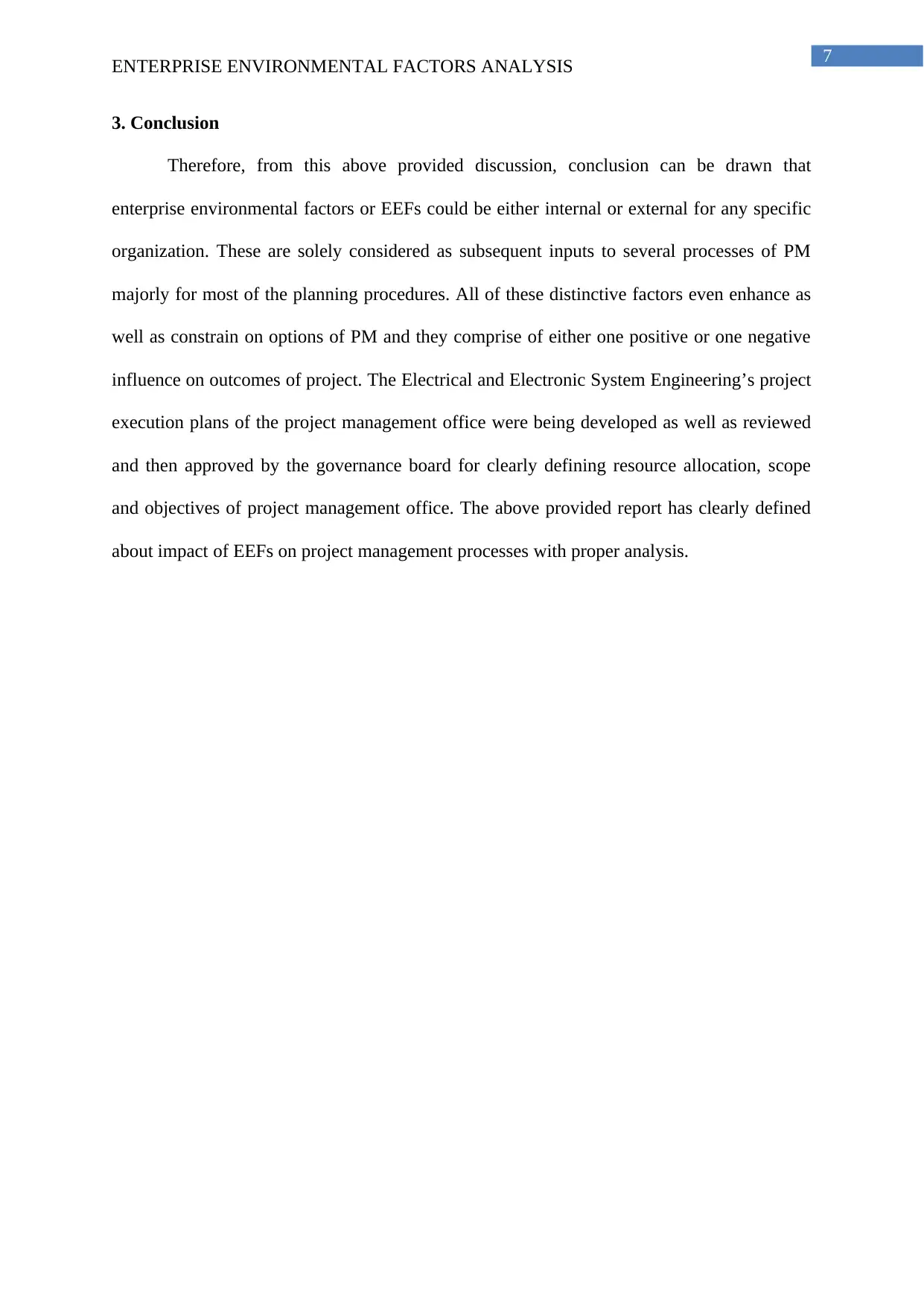
7
ENTERPRISE ENVIRONMENTAL FACTORS ANALYSIS
3. Conclusion
Therefore, from this above provided discussion, conclusion can be drawn that
enterprise environmental factors or EEFs could be either internal or external for any specific
organization. These are solely considered as subsequent inputs to several processes of PM
majorly for most of the planning procedures. All of these distinctive factors even enhance as
well as constrain on options of PM and they comprise of either one positive or one negative
influence on outcomes of project. The Electrical and Electronic System Engineering’s project
execution plans of the project management office were being developed as well as reviewed
and then approved by the governance board for clearly defining resource allocation, scope
and objectives of project management office. The above provided report has clearly defined
about impact of EEFs on project management processes with proper analysis.
ENTERPRISE ENVIRONMENTAL FACTORS ANALYSIS
3. Conclusion
Therefore, from this above provided discussion, conclusion can be drawn that
enterprise environmental factors or EEFs could be either internal or external for any specific
organization. These are solely considered as subsequent inputs to several processes of PM
majorly for most of the planning procedures. All of these distinctive factors even enhance as
well as constrain on options of PM and they comprise of either one positive or one negative
influence on outcomes of project. The Electrical and Electronic System Engineering’s project
execution plans of the project management office were being developed as well as reviewed
and then approved by the governance board for clearly defining resource allocation, scope
and objectives of project management office. The above provided report has clearly defined
about impact of EEFs on project management processes with proper analysis.
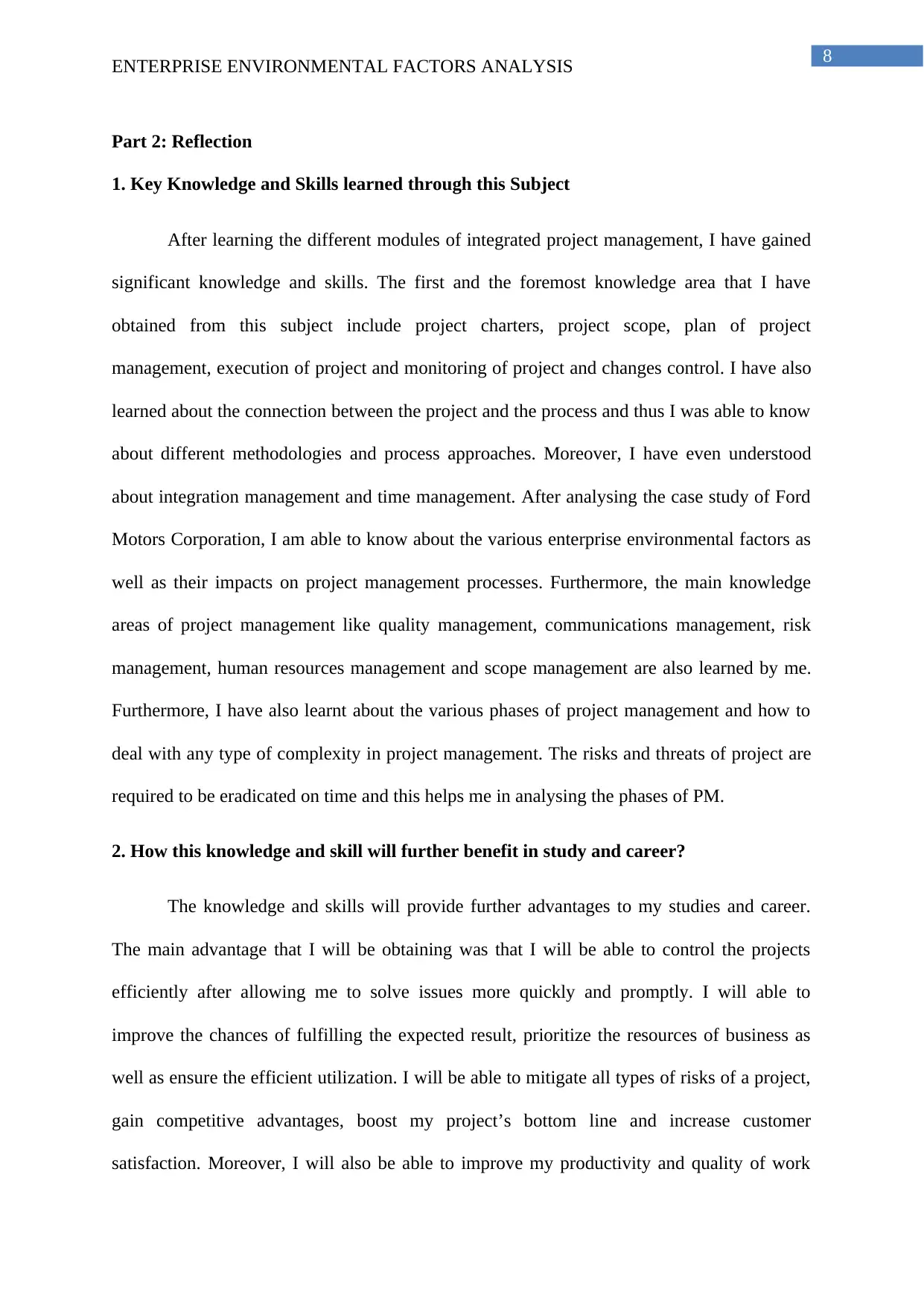
8
ENTERPRISE ENVIRONMENTAL FACTORS ANALYSIS
Part 2: Reflection
1. Key Knowledge and Skills learned through this Subject
After learning the different modules of integrated project management, I have gained
significant knowledge and skills. The first and the foremost knowledge area that I have
obtained from this subject include project charters, project scope, plan of project
management, execution of project and monitoring of project and changes control. I have also
learned about the connection between the project and the process and thus I was able to know
about different methodologies and process approaches. Moreover, I have even understood
about integration management and time management. After analysing the case study of Ford
Motors Corporation, I am able to know about the various enterprise environmental factors as
well as their impacts on project management processes. Furthermore, the main knowledge
areas of project management like quality management, communications management, risk
management, human resources management and scope management are also learned by me.
Furthermore, I have also learnt about the various phases of project management and how to
deal with any type of complexity in project management. The risks and threats of project are
required to be eradicated on time and this helps me in analysing the phases of PM.
2. How this knowledge and skill will further benefit in study and career?
The knowledge and skills will provide further advantages to my studies and career.
The main advantage that I will be obtaining was that I will be able to control the projects
efficiently after allowing me to solve issues more quickly and promptly. I will able to
improve the chances of fulfilling the expected result, prioritize the resources of business as
well as ensure the efficient utilization. I will be able to mitigate all types of risks of a project,
gain competitive advantages, boost my project’s bottom line and increase customer
satisfaction. Moreover, I will also be able to improve my productivity and quality of work
ENTERPRISE ENVIRONMENTAL FACTORS ANALYSIS
Part 2: Reflection
1. Key Knowledge and Skills learned through this Subject
After learning the different modules of integrated project management, I have gained
significant knowledge and skills. The first and the foremost knowledge area that I have
obtained from this subject include project charters, project scope, plan of project
management, execution of project and monitoring of project and changes control. I have also
learned about the connection between the project and the process and thus I was able to know
about different methodologies and process approaches. Moreover, I have even understood
about integration management and time management. After analysing the case study of Ford
Motors Corporation, I am able to know about the various enterprise environmental factors as
well as their impacts on project management processes. Furthermore, the main knowledge
areas of project management like quality management, communications management, risk
management, human resources management and scope management are also learned by me.
Furthermore, I have also learnt about the various phases of project management and how to
deal with any type of complexity in project management. The risks and threats of project are
required to be eradicated on time and this helps me in analysing the phases of PM.
2. How this knowledge and skill will further benefit in study and career?
The knowledge and skills will provide further advantages to my studies and career.
The main advantage that I will be obtaining was that I will be able to control the projects
efficiently after allowing me to solve issues more quickly and promptly. I will able to
improve the chances of fulfilling the expected result, prioritize the resources of business as
well as ensure the efficient utilization. I will be able to mitigate all types of risks of a project,
gain competitive advantages, boost my project’s bottom line and increase customer
satisfaction. Moreover, I will also be able to improve my productivity and quality of work
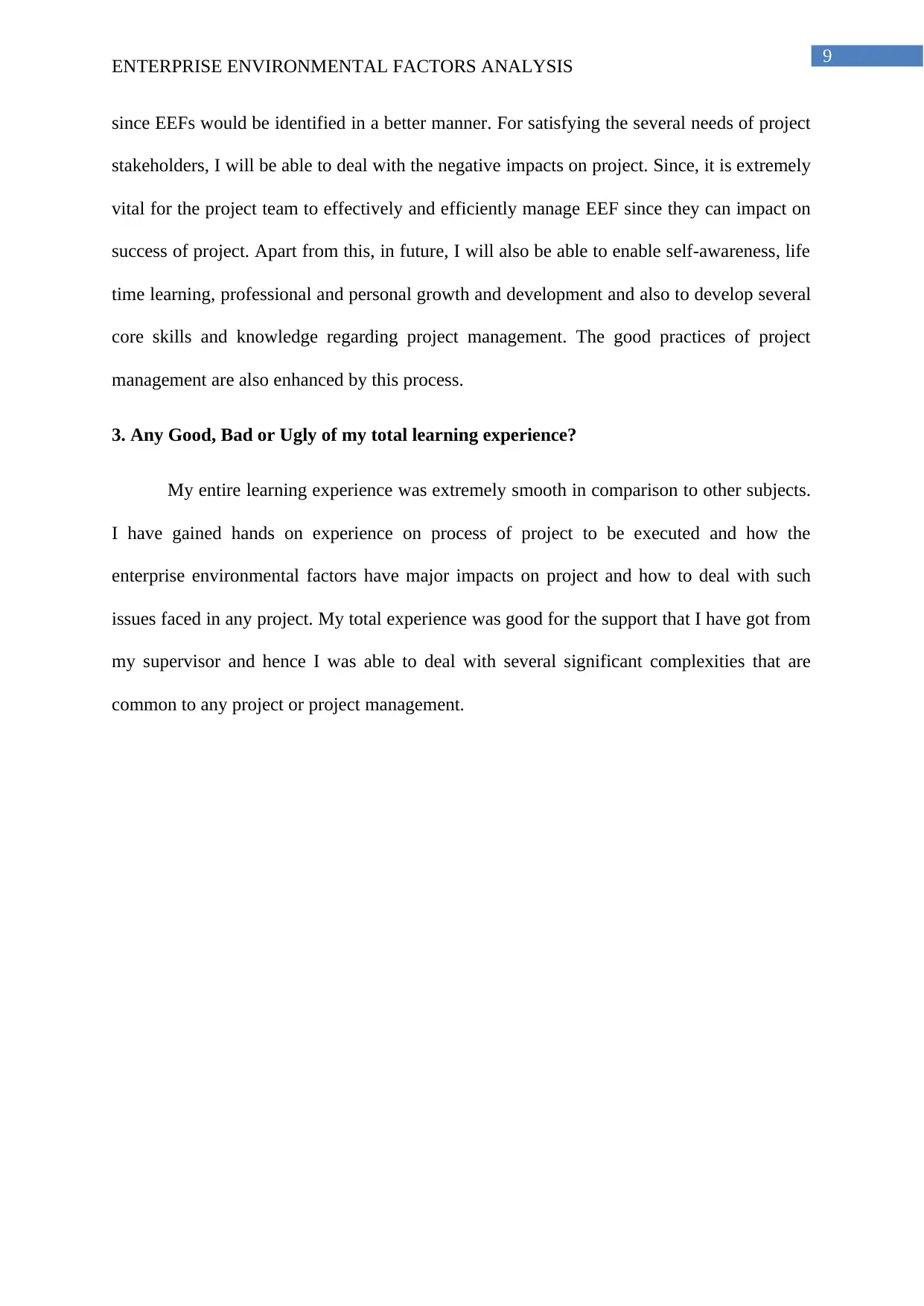
9
ENTERPRISE ENVIRONMENTAL FACTORS ANALYSIS
since EEFs would be identified in a better manner. For satisfying the several needs of project
stakeholders, I will be able to deal with the negative impacts on project. Since, it is extremely
vital for the project team to effectively and efficiently manage EEF since they can impact on
success of project. Apart from this, in future, I will also be able to enable self-awareness, life
time learning, professional and personal growth and development and also to develop several
core skills and knowledge regarding project management. The good practices of project
management are also enhanced by this process.
3. Any Good, Bad or Ugly of my total learning experience?
My entire learning experience was extremely smooth in comparison to other subjects.
I have gained hands on experience on process of project to be executed and how the
enterprise environmental factors have major impacts on project and how to deal with such
issues faced in any project. My total experience was good for the support that I have got from
my supervisor and hence I was able to deal with several significant complexities that are
common to any project or project management.
ENTERPRISE ENVIRONMENTAL FACTORS ANALYSIS
since EEFs would be identified in a better manner. For satisfying the several needs of project
stakeholders, I will be able to deal with the negative impacts on project. Since, it is extremely
vital for the project team to effectively and efficiently manage EEF since they can impact on
success of project. Apart from this, in future, I will also be able to enable self-awareness, life
time learning, professional and personal growth and development and also to develop several
core skills and knowledge regarding project management. The good practices of project
management are also enhanced by this process.
3. Any Good, Bad or Ugly of my total learning experience?
My entire learning experience was extremely smooth in comparison to other subjects.
I have gained hands on experience on process of project to be executed and how the
enterprise environmental factors have major impacts on project and how to deal with such
issues faced in any project. My total experience was good for the support that I have got from
my supervisor and hence I was able to deal with several significant complexities that are
common to any project or project management.
Secure Best Marks with AI Grader
Need help grading? Try our AI Grader for instant feedback on your assignments.
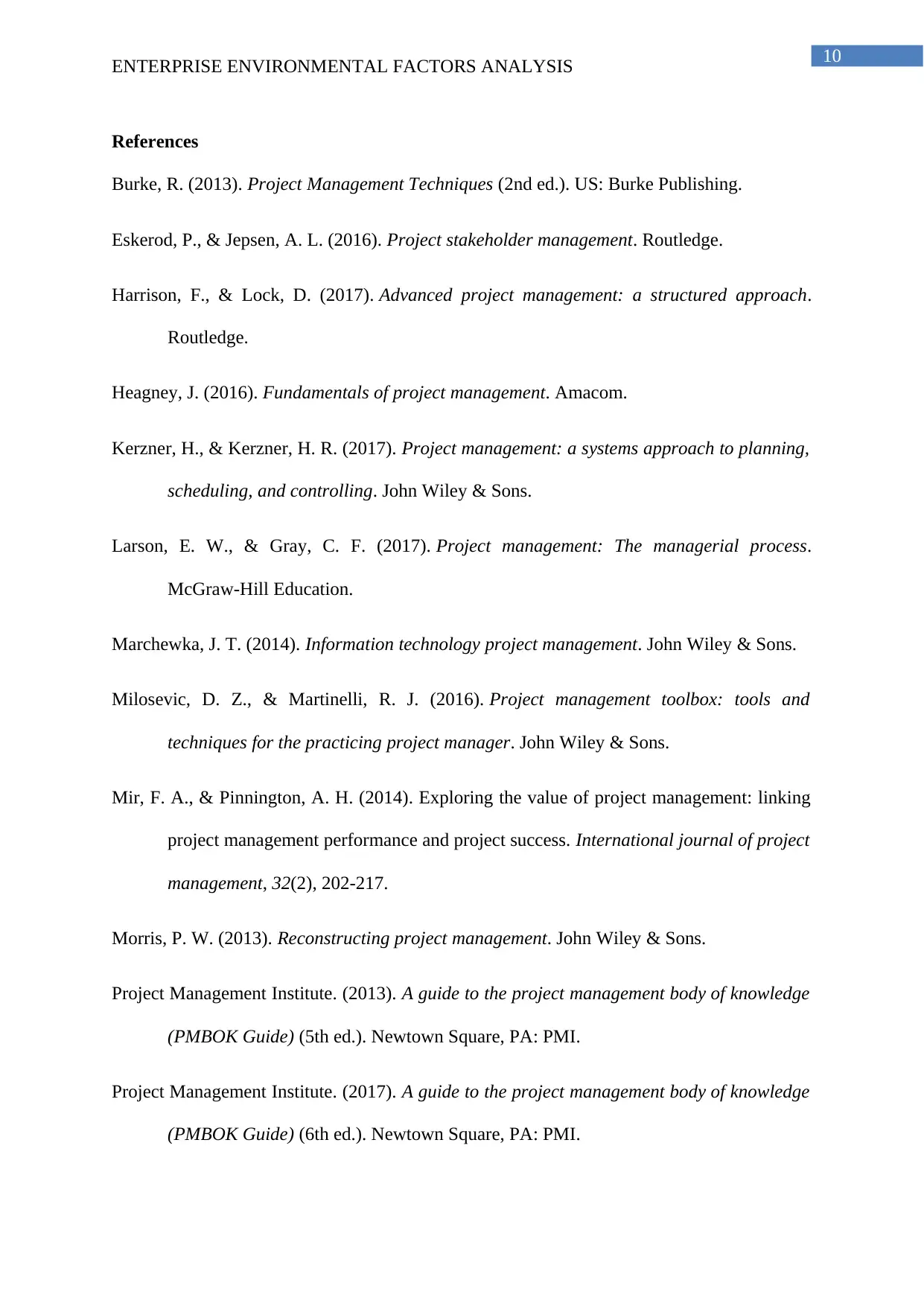
10
ENTERPRISE ENVIRONMENTAL FACTORS ANALYSIS
References
Burke, R. (2013). Project Management Techniques (2nd ed.). US: Burke Publishing.
Eskerod, P., & Jepsen, A. L. (2016). Project stakeholder management. Routledge.
Harrison, F., & Lock, D. (2017). Advanced project management: a structured approach.
Routledge.
Heagney, J. (2016). Fundamentals of project management. Amacom.
Kerzner, H., & Kerzner, H. R. (2017). Project management: a systems approach to planning,
scheduling, and controlling. John Wiley & Sons.
Larson, E. W., & Gray, C. F. (2017). Project management: The managerial process.
McGraw-Hill Education.
Marchewka, J. T. (2014). Information technology project management. John Wiley & Sons.
Milosevic, D. Z., & Martinelli, R. J. (2016). Project management toolbox: tools and
techniques for the practicing project manager. John Wiley & Sons.
Mir, F. A., & Pinnington, A. H. (2014). Exploring the value of project management: linking
project management performance and project success. International journal of project
management, 32(2), 202-217.
Morris, P. W. (2013). Reconstructing project management. John Wiley & Sons.
Project Management Institute. (2013). A guide to the project management body of knowledge
(PMBOK Guide) (5th ed.). Newtown Square, PA: PMI.
Project Management Institute. (2017). A guide to the project management body of knowledge
(PMBOK Guide) (6th ed.). Newtown Square, PA: PMI.
ENTERPRISE ENVIRONMENTAL FACTORS ANALYSIS
References
Burke, R. (2013). Project Management Techniques (2nd ed.). US: Burke Publishing.
Eskerod, P., & Jepsen, A. L. (2016). Project stakeholder management. Routledge.
Harrison, F., & Lock, D. (2017). Advanced project management: a structured approach.
Routledge.
Heagney, J. (2016). Fundamentals of project management. Amacom.
Kerzner, H., & Kerzner, H. R. (2017). Project management: a systems approach to planning,
scheduling, and controlling. John Wiley & Sons.
Larson, E. W., & Gray, C. F. (2017). Project management: The managerial process.
McGraw-Hill Education.
Marchewka, J. T. (2014). Information technology project management. John Wiley & Sons.
Milosevic, D. Z., & Martinelli, R. J. (2016). Project management toolbox: tools and
techniques for the practicing project manager. John Wiley & Sons.
Mir, F. A., & Pinnington, A. H. (2014). Exploring the value of project management: linking
project management performance and project success. International journal of project
management, 32(2), 202-217.
Morris, P. W. (2013). Reconstructing project management. John Wiley & Sons.
Project Management Institute. (2013). A guide to the project management body of knowledge
(PMBOK Guide) (5th ed.). Newtown Square, PA: PMI.
Project Management Institute. (2017). A guide to the project management body of knowledge
(PMBOK Guide) (6th ed.). Newtown Square, PA: PMI.
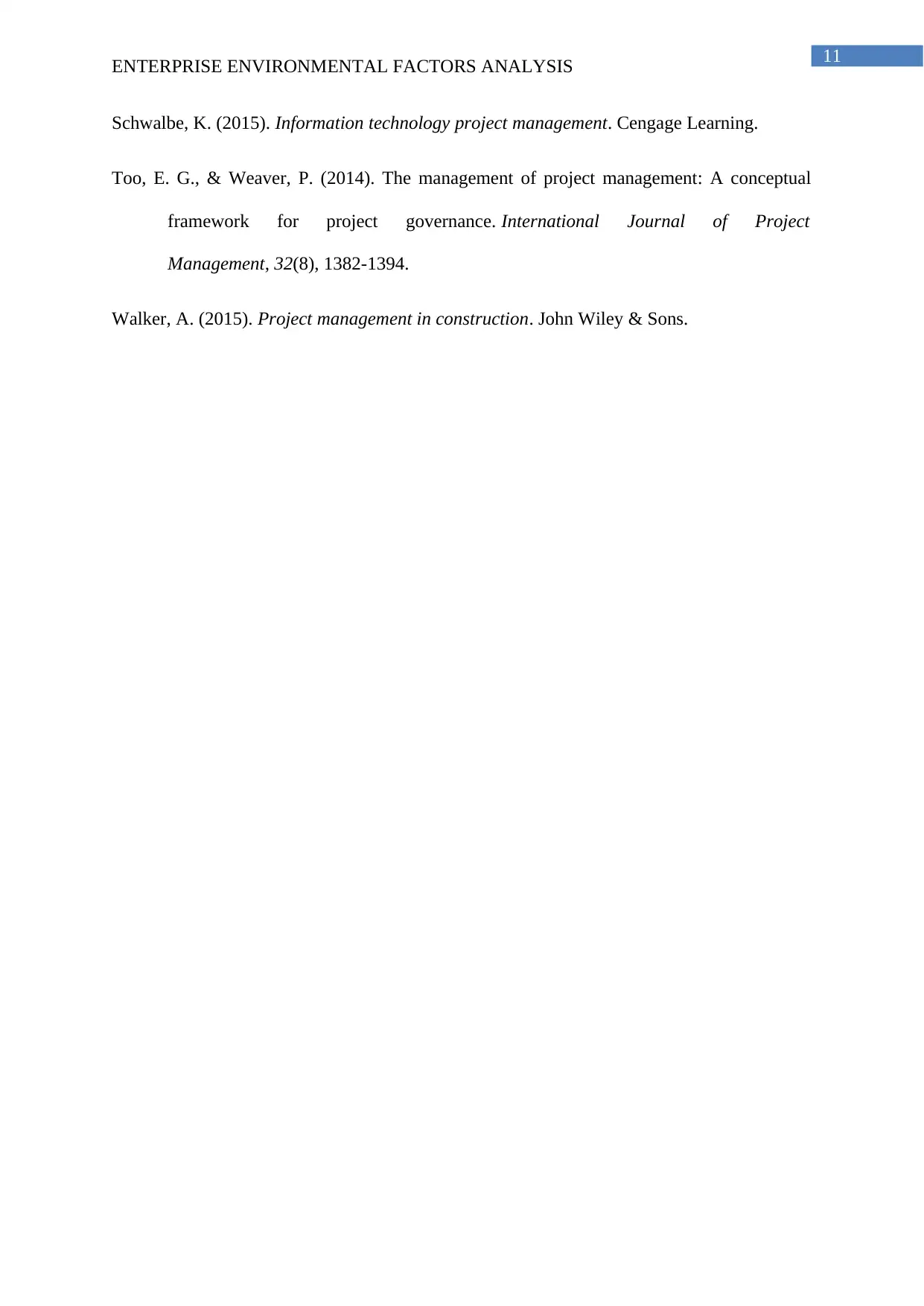
11
ENTERPRISE ENVIRONMENTAL FACTORS ANALYSIS
Schwalbe, K. (2015). Information technology project management. Cengage Learning.
Too, E. G., & Weaver, P. (2014). The management of project management: A conceptual
framework for project governance. International Journal of Project
Management, 32(8), 1382-1394.
Walker, A. (2015). Project management in construction. John Wiley & Sons.
ENTERPRISE ENVIRONMENTAL FACTORS ANALYSIS
Schwalbe, K. (2015). Information technology project management. Cengage Learning.
Too, E. G., & Weaver, P. (2014). The management of project management: A conceptual
framework for project governance. International Journal of Project
Management, 32(8), 1382-1394.
Walker, A. (2015). Project management in construction. John Wiley & Sons.
1 out of 12
Related Documents
Your All-in-One AI-Powered Toolkit for Academic Success.
+13062052269
info@desklib.com
Available 24*7 on WhatsApp / Email
![[object Object]](/_next/static/media/star-bottom.7253800d.svg)
Unlock your academic potential
© 2024 | Zucol Services PVT LTD | All rights reserved.





